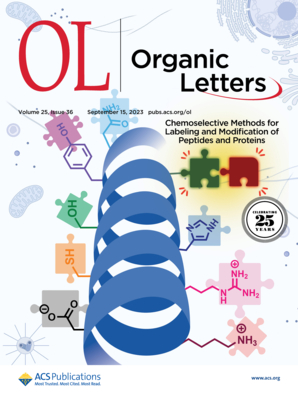一锅序贯醇活化及镍催化氯硅烷交叉亲电偶联
IF 5
1区 化学
Q1 CHEMISTRY, ORGANIC
引用次数: 0
摘要
报道了伯醇的正式脱氧硅基化反应。一锅法包括醇的原位溴化和随后的镍催化形成的烷基溴和各种乙烯基取代的氯硅烷的交叉亲电偶联。成功的关键是镍催化剂以及氯硅烷亲电试剂与前面溴化步骤的副产物的相容性,特别是与三苯基氧化膦可能作为过量镍催化剂的弱配体使用。本文章由计算机程序翻译,如有差异,请以英文原文为准。

One-Pot Sequential Alcohol Activation and Nickel-Catalyzed Cross-Electrophile Coupling with Chlorosilanes
A formal deoxygenative silylation of primary alcohols is reported. The one-pot procedure consists of an in situ bromination of the alcohol and a subsequent nickel-catalyzed cross-electrophile coupling of the formed alkyl bromide and various vinyl-substituted chlorosilanes. The key to success is the compatibility of the nickel catalysis as well as the chlorosilane electrophile with the byproducts of the preceding bromination step, especially with triphenylphosphine oxide likely acting as a weak ligand for the excess nickel catalyst used.
求助全文
通过发布文献求助,成功后即可免费获取论文全文。
去求助
来源期刊

Organic Letters
化学-有机化学
CiteScore
9.30
自引率
11.50%
发文量
1607
审稿时长
1.5 months
期刊介绍:
Organic Letters invites original reports of fundamental research in all branches of the theory and practice of organic, physical organic, organometallic,medicinal, and bioorganic chemistry. Organic Letters provides rapid disclosure of the key elements of significant studies that are of interest to a large portion of the organic community. In selecting manuscripts for publication, the Editors place emphasis on the originality, quality and wide interest of the work. Authors should provide enough background information to place the new disclosure in context and to justify the rapid publication format. Back-to-back Letters will be considered. Full details should be reserved for an Article, which should appear in due course.
 求助内容:
求助内容: 应助结果提醒方式:
应助结果提醒方式:


